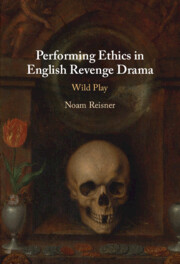Book contents
- Performing Ethics in English Revenge Drama
- Performing Ethics in English Revenge Drama
- Copyright page
- Dedication
- Contents
- Preface
- Introduction
- Chapter 1 Plot Holes and Empty Spaces
- Chapter 2 Dramatic Hyperboles
- Chapter 3 Wild Child’s Play
- Chapter 4 Marking the Ground of Revenge
- Chapter 5 Ghosting Shakespeare’s Hamlet
- Chapter 6 Passive Aggressors
- Epilogue
- Bibliography
- Index
Chapter 3 - Wild Child’s Play
Antitheatrical Moral Censure and Marston’s Revenge Satire
Published online by Cambridge University Press: 09 July 2024
- Performing Ethics in English Revenge Drama
- Performing Ethics in English Revenge Drama
- Copyright page
- Dedication
- Contents
- Preface
- Introduction
- Chapter 1 Plot Holes and Empty Spaces
- Chapter 2 Dramatic Hyperboles
- Chapter 3 Wild Child’s Play
- Chapter 4 Marking the Ground of Revenge
- Chapter 5 Ghosting Shakespeare’s Hamlet
- Chapter 6 Passive Aggressors
- Epilogue
- Bibliography
- Index
Summary
Looking ahead to Shakespeare’s Hamlet, Chapter 3 turns to the issue of antitheatrical sentiment and polemic and the pressure its moralising brought to bear on playwrights rethinking Kyd’s design. The chapter looks to Marston’s parody of Kyd (and possibly of Shakespeare) in Antonio’s Revenge as a case study of a highly innovative and satirical revenge play on this continuum which consciously comments on the metatheatrical ethics of its genre, and in so doing reflects on the didactic pressures exerted on Renaissance English playwrights to justify and sustain the moral coherence of their dramatic spectacle in practice. Marston’s ironic treatment of what had already become by the late 1590s trite dramatic conventions shows how one competitive playwright was exploring new dramatic possibilities within the genre which would allow his audience to test viable ethical alternatives to a queasy morality through a shared theatrical experience.
- Type
- Chapter
- Information
- Performing Ethics in English Revenge DramaWild Play, pp. 111 - 133Publisher: Cambridge University PressPrint publication year: 2024

